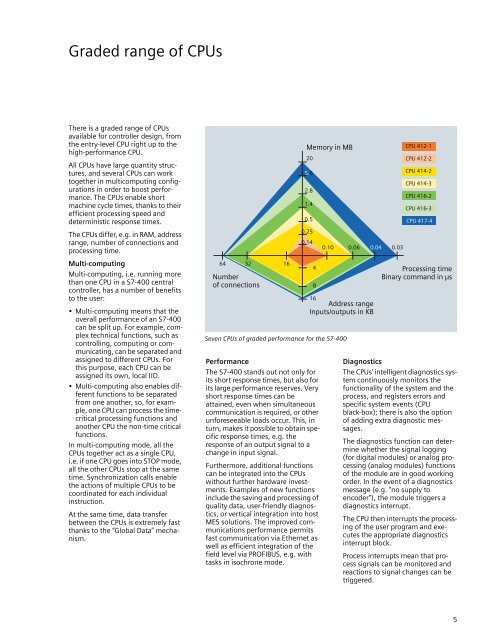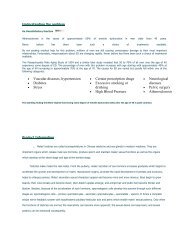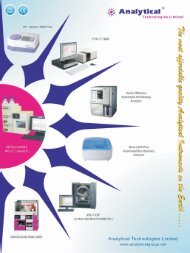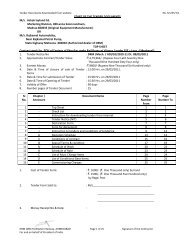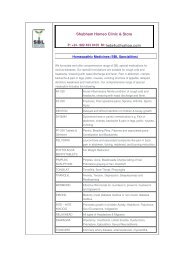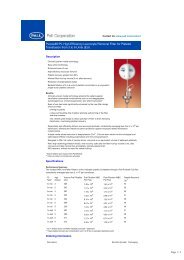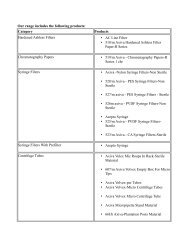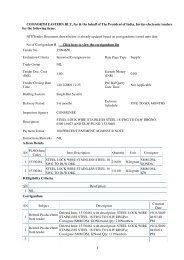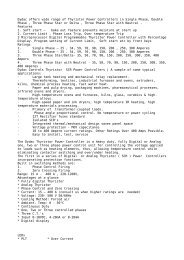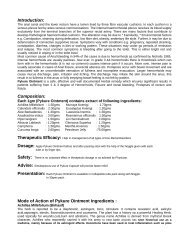SIMATIC S7-400 - The Power Controller for System ... - Jonweb FA
SIMATIC S7-400 - The Power Controller for System ... - Jonweb FA
SIMATIC S7-400 - The Power Controller for System ... - Jonweb FA
Create successful ePaper yourself
Turn your PDF publications into a flip-book with our unique Google optimized e-Paper software.
Graded range of CPUs<br />
<strong>The</strong>re is a graded range of CPUs<br />
available <strong>for</strong> controller design, from<br />
the entry-level CPU right up to the<br />
high-per<strong>for</strong>mance CPU.<br />
All CPUs have large quantity structures,<br />
and several CPUs can work<br />
together in multicomputing configurations<br />
in order to boost per<strong>for</strong>mance.<br />
<strong>The</strong> CPUs enable short<br />
machine cycle times, thanks to their<br />
efficient processing speed and<br />
deterministic response times.<br />
<strong>The</strong> CPUs differ, e.g. in RAM, address<br />
range, number of connections and<br />
processing time.<br />
Multi-computing<br />
Multi-computing, i.e. running more<br />
than one CPU in a <strong>S7</strong>-<strong>400</strong> central<br />
controller, has a number of benefits<br />
to the user:<br />
• Multi-computing means that the<br />
overall per<strong>for</strong>mance of an <strong>S7</strong>-<strong>400</strong><br />
can be split up. For example, complex<br />
technical functions, such as<br />
controlling, computing or communicating,<br />
can be separated and<br />
assigned to different CPUs. For<br />
this purpose, each CPU can be<br />
assigned its own, local I/O.<br />
• Multi-computing also enables different<br />
functions to be separated<br />
from one another, so, <strong>for</strong> example,<br />
one CPU can process the timecritical<br />
processing functions and<br />
another CPU the non-time critical<br />
functions.<br />
In multi-computing mode, all the<br />
CPUs together act as a single CPU,<br />
i.e. if one CPU goes into STOP mode,<br />
all the other CPUs stop at the same<br />
time. Synchronization calls enable<br />
the actions of multiple CPUs to be<br />
coordinated <strong>for</strong> each individual<br />
instruction.<br />
At the same time, data transfer<br />
between the CPUs is extremely fast<br />
thanks to the “Global Data” mechanism.<br />
64<br />
32<br />
Number<br />
of connections<br />
Seven CPUs of graded per<strong>for</strong>mance <strong>for</strong> the <strong>S7</strong>-<strong>400</strong><br />
16<br />
Per<strong>for</strong>mance<br />
<strong>The</strong> <strong>S7</strong>-<strong>400</strong> stands out not only <strong>for</strong><br />
its short response times, but also <strong>for</strong><br />
its large per<strong>for</strong>mance reserves. Very<br />
short response times can be<br />
attained, even when simultaneous<br />
communication is required, or other<br />
un<strong>for</strong>eseeable loads occur. This, in<br />
turn, makes it possible to obtain specific<br />
response times, e.g. the<br />
response of an output signal to a<br />
change in input signal.<br />
Furthermore, additional functions<br />
can be integrated into the CPUs<br />
without further hardware investments.<br />
Examples of new functions<br />
include the saving and processing of<br />
quality data, user-friendly diagnostics,<br />
or vertical integration into host<br />
MES solutions. <strong>The</strong> improved communications<br />
per<strong>for</strong>mance permits<br />
fast communication via Ethernet as<br />
well as efficient integration of the<br />
field level via PROFIBUS, e.g. with<br />
tasks in isochrone mode.<br />
Memory in MB<br />
20<br />
5.6<br />
2.8<br />
1.4<br />
0.5<br />
0.25<br />
0.14<br />
4<br />
8<br />
16<br />
0.10 0.06 0.04<br />
Address range<br />
Inputs/outputs in KB<br />
0.03<br />
CPU 412-1<br />
CPU 412-2<br />
CPU 414-2<br />
CPU 414-3<br />
CPU 416-2<br />
CPU 416-3<br />
CPU 417-4<br />
Processing time<br />
Binary command in µs<br />
Diagnostics<br />
<strong>The</strong> CPUs’ intelligent diagnostics system<br />
continuously monitors the<br />
functionality of the system and the<br />
process, and registers errors and<br />
specific system events (CPU<br />
black-box); there is also the option<br />
of adding extra diagnostic messages.<br />
<strong>The</strong> diagnostics function can determine<br />
whether the signal logging<br />
(<strong>for</strong> digital modules) or analog processing<br />
(analog modules) functions<br />
of the module are in good working<br />
order. In the event of a diagnostics<br />
message (e.g. “no supply to<br />
encoder”), the module triggers a<br />
diagnostics interrupt.<br />
<strong>The</strong> CPU then interrupts the processing<br />
of the user program and executes<br />
the appropriate diagnostics<br />
interrupt block.<br />
Process interrupts mean that process<br />
signals can be monitored and<br />
reactions to signal changes can be<br />
triggered.<br />
5


